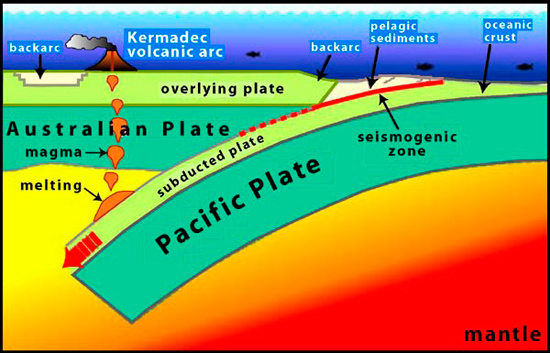What is the Theory of Tectonic Plate Movement

According to the theory of plate tectonics, the earth’s lithosphere, the surface or crust, is not one single continuous slab. Instead, the surface is divided into plates (about 7 to 8 large ones). Plate tectonics theory was instrumental in further developing the continental drift theory, which was widely discounted in its early stages.
The continental drift theory hypothesized that the continents as we know today, were once together and have drifted apart over millions of years. While evidence like similar species found on corresponding continental boundaries and the jigsaw puzzle like fit was present, the theory was discounted due to lack of one major element, a force which would be responsible for moving the continents away.
That problem was solved after the concept of seafloor spreading came to light and then when the theory of plate tectonics developed further it superseded the continental drift theory because of a much better explanation.
Instructions
-
1
Basic principles
Plate tectonics theory focuses on the earth’s outermost layers, the lithosphere and the asthenosphere. While the lithosphere is a solid crust, the asthenosphere, found under the lithosphere, is said to be more fluid, allowing the lithosphere to float on it.
The lithosphere itself is believed to consist of oceanic crust and continental crust. The oceanic crust is a result of seafloor spreading while continental crust is formed by arc volcanism. The location where two plate boundaries meet is known as the plate boundary and is often where most of the physical changes, earthquakes and volcanic activity take place. -
2
Types of plate boundaries
Transform boundaries: In these locations two plates slide or grind against each other, resulting in faults. The relative motion of the plates can either be towards the left or the right and California’s San Andreas fault is one example of what transform boundaries can result in.
Divergent boundaries: These locations are often where new crust is created and are found in oceans. Here two plates move apart from each other, creating a gap, which is then filled by upwelling magma. The magma then cools down and creates new crust. Mid-ocean ridges and rift zones are examples of these boundaries.
Convergent boundaries: In contrast to divergent boundaries, convergent boundaries are where two plates move towards each other and meet. This can result in a subduction zone being formed, where one plate moves below the other and is destroyed as it goes deeper, or mountain formation, as is the case with the Andes mountainge range.







